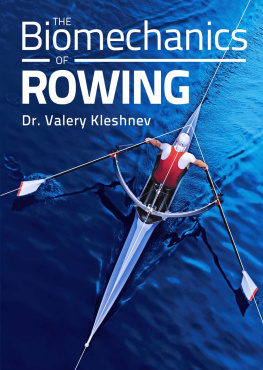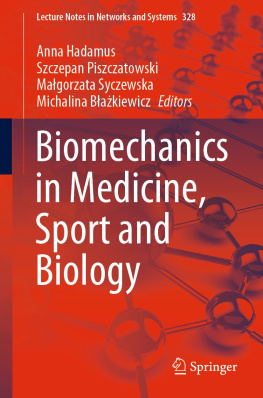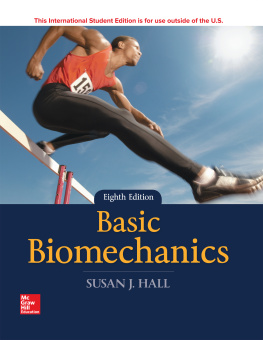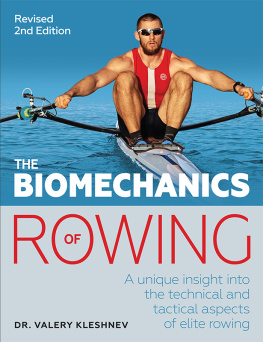Valery Kleshnev - Biomechanics of Rowing
Here you can read online Valery Kleshnev - Biomechanics of Rowing full text of the book (entire story) in english for free. Download pdf and epub, get meaning, cover and reviews about this ebook. year: 2020, publisher: Crowood, genre: Children. Description of the work, (preface) as well as reviews are available. Best literature library LitArk.com created for fans of good reading and offers a wide selection of genres:
Romance novel
Science fiction
Adventure
Detective
Science
History
Home and family
Prose
Art
Politics
Computer
Non-fiction
Religion
Business
Children
Humor
Choose a favorite category and find really read worthwhile books. Enjoy immersion in the world of imagination, feel the emotions of the characters or learn something new for yourself, make an fascinating discovery.
- Book:Biomechanics of Rowing
- Author:
- Publisher:Crowood
- Genre:
- Year:2020
- Rating:4 / 5
- Favourites:Add to favourites
- Your mark:
- 80
- 1
- 2
- 3
- 4
- 5
Biomechanics of Rowing: summary, description and annotation
We offer to read an annotation, description, summary or preface (depends on what the author of the book "Biomechanics of Rowing" wrote himself). If you haven't found the necessary information about the book — write in the comments, we will try to find it.
Biomechanics of Rowing — read online for free the complete book (whole text) full work
Below is the text of the book, divided by pages. System saving the place of the last page read, allows you to conveniently read the book "Biomechanics of Rowing" online for free, without having to search again every time where you left off. Put a bookmark, and you can go to the page where you finished reading at any time.
Font size:
Interval:
Bookmark:

First published in 2016 by
The Crowood Press Ltd
Ramsbury, Marlborough
Wiltshire SN8 2HR
www.crowood.com
Dr Valery Kleshnev 2016
All rights reserved. No part of this publication may be reproduced or transmitted in any form or by any means, electronic or mechanical, including photocopy, recording, or any information storage and retrieval system, without permission in writing from the publishers.
British Library Cataloguing-in-Publication Data
A catalogue record for this book is available from the British Library.
ISBN 978 1 78500 134 5
This book is intended for rowers and coaches who want to improve their rowing technique, row faster and maximize their results in regattas, given their physical conditioning. Here I have tried to summarize my knowledge of rowing biomechanics, which was obtained from nearly thirty years of working with thousands of rowers and coaches from all around the world: from Europe to Australia, from China to the USA and Brazil. Many of them ended up being Olympic and World champions and I have learned a lot from them. This knowledge didnt come as a divine revelation but is a product of extensive measurements and analysis, continuous attempts to solve many puzzles and exhaustive studies of the efficiency techniques of winning crews. Though inspiration is still important, I believe the only way to achieve it is through hard work and continuous thought.
I can say that my understanding of rowing biomechanics and technique is completely different now from that in 1986, which is when I finished my fourteen-year rowing career and started pursuing sport science. It was a very steep learning curve. In the beginning I had very limited instrumentation and had to rely on experts and literature, which mainly emphasized the importance of smooth boat speed and so on. If someone had asked me at the time How should the best force curve look? my answer would have been quite evasive: It is possible to win with various force curves. I just didnt know. Now I realize how many mistakes we made at that time.
The logical question that I always ask myself is Are you sure now that all these conclusions are true? The answer I give is: They should be correct, on the basis of all the available evidence and its analysis. However, if new facts contradicting the theory should be found, or someone finds an error in the analysis, I have to revise it and develop a new theory. Of course, misconceptions are always possible, but at least I try to be open-minded.
For example, a few years ago I thought that a pair of horizontal forces at the handle and the stretcher might create a torque, which could lift the whole rower-boat system out of the water and decrease drag resistance. My colleague and friend Prof. Volker Nolte from Canada had an opposite opinion and counted only a rowers vertical accelerations, but I was still hoping that a true lift force might exist. After a few quite sophisticated experiments (see sport scientist, but from a master rower and engineer, Tor Anderson from California, who suggested an effect of centripetal force, which we had both overlooked.
Very often, the reason for changing the concept is not a fault or mistake but due to new data being obtained when new instrumentation becomes available. For example, a few years ago the dominating winning race strategy was one that encouraged the fastest start. Now we can see a change in this trend, where more and more winners use a more even distribution of effort during the race.
Most of the information in this book could be found in the Rowing Biomechanics Newslet ter (RBN), which I write and publish, and have done so monthly since 2001. My original reason to start this project was to keep my brain active in my speciality. Later it became a great tool not only for sharing ideas but also for their discussion and verification. Many thanks to all the contributors whose comments were very valuable in correcting errors and mistakes, obtaining new ideas and making the advance in rowing biomechanics possible. However, this book is not a simple compilation of newsletters. All the information was revised and structured and many contradictions accumulated over the years were corrected.
Quite a common approach as a way of improving rowing technique is to look at winning crews in an attempt to copy them, without considering why they are fast. However, nothing thats worthwhile is ever easy, especially in rowing. Some crews are not winning just because they are; they win in spite of their technique by means of higher physiological power and stronger, better motivation. A large variety of rowing techniques could be found in winners of Elite regattas, so which one should you copy? Remember, a copy is always going to be worse than the original.
I propose a different approach, which is not as easy; it requires some extra efforts and brain power but will help you produce much more consistent and reliable results. What this book can offer you is an understanding of how it works, and why. This is a sort of mosaic, a completed puzzle, where the bits and pieces of rowing technique are placed in an organized manner and bound together through mechanical principles. This is not a simple system, and is sometimes controversial. You may try to improve one efficiency component, but lose more on another one. Therefore, using common sense is the rule of thumb here, and all ideas must always be verified empirically with actual rowing results.
This book is also for sport scientists: for people who want to measure numbers in rowing, relate them to technique and give specific advice to coaches and rowers. In general, sport biomechanics is a very specific science, much more than physiology, psychology or nutrition. Sporting technique is completely different in various sports, for example between rowing and swimming, canoeing and athletics, so there are very different analytical models and criteria of effectiveness, measurement methods and equipment. The biomechanical equipment is usually custom-made, and we cant, as it were, go and buy it in a shop, unlike the skills of other sport scientists. It takes many years for a biomechanic scientist to obtain professional expertise in a specific area, and they usually cant work across many sports and switch between them quickly, as other sport scientists can do.
Biomechanical models can be very complicated, with many important unknown variables. Sometimes, if you blindly follow an incorrect model, the outcome could even be counter-productive and decrease performance instead of improving it. Again, common sense and continuous verification of your ideas with practical results are absolutely necessary.
Rowing is a unique sport due to its technical complexity, which is defined by the following factors:
These factors make rowing a very technical sport and explain why rowing biomechanics is so important for developing an effective technique and achieving good results in this sport. Technique is not the only important component of rowing performance; a high physiological capacity is also compulsory. The top results can be achieved only through a combination of these two main factors together with mental toughness. There was evidence (comparison of erg scores and on-water results) showing that an effective technique could make the boat 35 per cent faster (1015 seconds over a 2km race) at the same physiological power production, which is the difference in speed between gold medallists and sixth-placed B-finalists at Elite regattas.
Next pageFont size:
Interval:
Bookmark:
Similar books «Biomechanics of Rowing»
Look at similar books to Biomechanics of Rowing. We have selected literature similar in name and meaning in the hope of providing readers with more options to find new, interesting, not yet read works.
Discussion, reviews of the book Biomechanics of Rowing and just readers' own opinions. Leave your comments, write what you think about the work, its meaning or the main characters. Specify what exactly you liked and what you didn't like, and why you think so.










